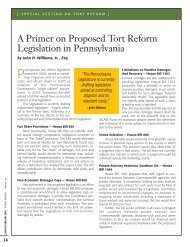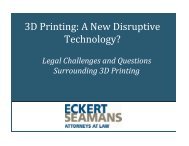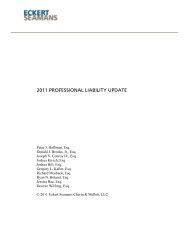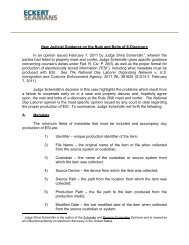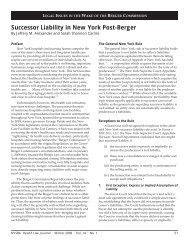B. Elements of a Cause of Action for Legal Malpractice – Breach of ContractIn Fiorentino v. Rapoport, 693 A.2d 208 (Pa. Super. Ct. 1997), appeal denied, 701 A.2d577 (Pa. 1997), the court noted that a claim of legal malpractice can be based on a breach ofcontract theory. See also Meyers v. Sudfeld, 2006 WL 401855 (E.D. Pa. 2006) (Pennsylvanialaw allows a client to bring a legal malpractice claim in both assumpsit (contract) and trespass(tort)). The court stated that in such an action the attorney’s liability must be assessed under theterms of the contract (i.e., did the attorney contract to bring about a specific legal result/eventand fail to do so?). Similarly, a legal malpractice action can be based on a breach of contracttheory if “the attorney agrees to provide his or her best efforts and fails to do so.” Id. at 213; seealso Sherman Indus., Inc. v. Goldhammer, et al., 683 F. Supp. 502, 506 (E.D. Pa. 1988) (legalmalpractice action can be based on breach of contract theory if Defendant/attorney breachedspecific contractual term, made and breached a specific promise upon which Plaintiff/clientreasonably relied to their detriment, or failed to follow specific instructions from Plaintiff/client);Costello v. Primavera, 39 Pa. D. & C. 4th 502 (Phila. Cty. Ct.Com. Pl. 1998), aff’d withoutpublished opinion, 748 A.2d 1257 (Pa. Super. Ct. 1999), appeal denied, 760 A.2d 854 (Pa.2000); Red Bell Brewing Co. v. Buchanan Ingersoll, P.C., 51 Pa. D. & C. 4th 129 (Phila. Cty. Ct.Com. Pl. 2001) (Plaintiff allowed to proceed to trial on breach of contract theory wherecomplaint alleged facts that would establish breach of Defendant’s contractual promises to“deliver to [Plaintiff] quality legal services” and to handle Plaintiff’s account “with the utmost ofprofessionalism and proficiency at all times”); Jackson v. Ferrera, No. 01-5365, 2002 U.S. Dist.LEXIS 12731 (E.D. Pa. Apr. 16, 2002) (while both contract and tort theories provide anappropriate framework for legal malpractice claims, Plaintiff may combine them in onemalpractice complaint only by asserting that Defendants have breached specific contractualterms as well as the attorney’s general duty of care); Edwards v. Duane, Morris & Heckscher,LLP, No. 01-4798, 2002 U.S. Dist. LEXIS 16301 (E.D. Pa. Aug. 15, 2002) (to sustain a claim oflegal malpractice based upon breach of contract, Plaintiff must “raise an issue as to whether itspecifically instructed the Defendant to perform a task that the Defendant failed to perform, or asto whether the Defendant made a specific promise upon which Plaintiff reasonably relied to itsdetriment”) (citing Sherman Indus., 683 F. Supp. at 506); Gorski v. Smith, 812 A.2d 683 (Pa.Super. Ct. 2002), appeal denied, 856 A.2d 834 (Pa. 2004) (breach of contract claim can bepremised on attorney’s failure to fulfill contractual duty to provide the agreed upon legal servicesin “a manner consistent with the profession at large”); Burns v. Drier, 12 Pa. D. & C.5th 479(Centre Co. June 6, 2010) (court dismissed defendant’s preliminary objections that Plaintiff didnot allege violation of a specific provision noting that “averments that the attorney violatedspecific instructions are not necessary in a breach of contract action for legal malpractice.”).C. The “Increased Risk of Harm” Standard Does Not ApplyTo Legal Malpractice ActionsIn Myers v. Seigle, 751 A.2d 1182 (Pa. Super. Ct. 2000), appeal denied, 795 A.2d 978(Pa. 2000), the Superior Court addressed the novel issue of whether the “increased risk of harm”standard should be applied to a legal malpractice cause of action. Plaintiff in this case allegedthat the lawyers who represented her in the underlying personal injury suit had been negligent infailing to conduct an adequate investigation of her accident and in failing to have her car148
inspected for design and manufacturing defects. Summary judgment had been entered in favorof the car manufacturer because she could not offer any evidence of the cause of the accident.In her subsequent legal malpractice action, Plaintiff claimed that her lawyers’ negligentspoliation of the evidence (her car) had precluded any possibility that she would prevail in thebreach of warranty and products liability action. The Superior Court held, however, that theincreased risk of harm standard, defined at The Restatement (Second) of Torts, § 323, wasinapplicable to a legal malpractice action. Rather, proof of actual loss is required. To prove suchloss, Plaintiff “must demonstrate that she would have prevailed in the underlying action in theabsence of [her lawyers’] alleged negligence.” Id. at 1185. Finding that she had suffered noactual injury from the alleged negligent conduct, the Court affirmed the grant of summaryjudgment in favor of Defendants.D. SettlementIn Muhammad v. Strassburger, McKenna, Messer, Shilobod & Gutnick, 587 A.2d 1346,1348 (Pa. 1991), reargument denied, 598 A.2d 27 (Pa. 1991), cert. denied, 502 U.S. 867 (1991),the Pennsylvania Supreme Court decided “we will not permit a suit to be filed by a dissatisfiedPlaintiff against his attorney following a settlement to which that Plaintiff agreed, unless thatPlaintiff can show he was fraudulently induced to settle the original action.”In Wassall v. DeCaro, 91 F.3d 443 (3d Cir. 1996), the Third Circuit held that Plaintiffscould maintain their legal malpractice action against their former attorney even though theyagreed to a dismissal because of the attorneys’ failure to prosecute the action. The courtobserved that the policies expressed in Muhammad would be served by allowing this action to goforward because the attorney’s failure to settle the matter, as the clients wished, ran counter tothe policy of encouraging settlements. Id. at 449. The Wassall Court noted that where anattorney delays inordinately in prosecuting a claim “forc[ing] a client to accept a dismissal of thecase, allowing a subsequent malpractice action serves as a systemic deterrent for this behaviorand thus promotes the policies articulated in Muhammad.” Id. at 449.In McMahon v. Shea, 688 A.2d 1179 (Pa. 1997), the Supreme Court was presented withan issue involving the application of the Court’s decision in Muhammad to a legal malpracticeaction based upon alleged attorney negligence in the drafting and execution of a propertysettlement agreement in a domestic relations matter. Specifically, Defendant-attorneys advisedMr. McMahon to enter into a written settlement agreement which was incorporated but notmerged into a final divorce decree. The agreement provided that half of Mr. McMahon’spayments to his ex-wife were deemed to be child support and the other half was deemedalimony. The only provision for termination of these payments is a clause referring to the timewhen the “youngest living child reaches the age of twenty-one, is emancipated or finishescollege, whichever occurs last.” Id. at 1180. As a result of this advice, the Court directed Mr.McMahon to continue to pay alimony to his former wife even after she had remarried, holdingthat the parties’ agreement had survived the decree of divorce.Mr. McMahon thereafter filed a legal malpractice action alleging that Defendantattorneys’failure to merge the alimony agreement with the final divorce decree constituted abreach of their duty to exercise reasonable care on his behalf. Defendants contended that the149
- Page 3 and 4:
EMTALA CASES ......................
- Page 5:
Filing an Affidavit of Non-Involvem
- Page 8 and 9:
II.PROFESSIONAL LIABILITY - AN OVER
- Page 10 and 11:
The Superior Court reversed the tri
- Page 12 and 13:
to a third party pursuant to the st
- Page 14 and 15:
After approximately five months, De
- Page 16 and 17:
learned the day after the surgery t
- Page 18 and 19:
conduct to the delay in colon cance
- Page 20 and 21:
court admitted the expert’s testi
- Page 22 and 23:
(b)(c)other reasonable causes, incl
- Page 24 and 25:
corroborated his testimony. The cou
- Page 26 and 27:
husband’s estate. Plaintiff alleg
- Page 28 and 29:
Other notable federal cases arising
- Page 30 and 31:
The Superior Court found that in re
- Page 32 and 33:
§ 1303.512(b). The court, however,
- Page 34 and 35:
In Neidig v. United States, No. 07-
- Page 36 and 37:
Additionally, the Supreme Court not
- Page 38 and 39:
were not indicated for her conditio
- Page 40 and 41:
surgeon is the same as it would be
- Page 42 and 43:
It should be noted that the Superio
- Page 44 and 45:
Finally, the court held that the tr
- Page 46 and 47:
The Supreme Court of Pennsylvania r
- Page 48 and 49:
nurses deviating from applicable st
- Page 50 and 51:
certainty, the court reviews expert
- Page 52 and 53:
Under Pennsylvania law, the Court n
- Page 54 and 55:
testimony, Defendant presented his
- Page 56 and 57:
Following Cooper v. Roberts, 286 A.
- Page 58 and 59:
Plaintiff developed chronic diarrhe
- Page 60 and 61:
where payment is made by Medicaid w
- Page 62 and 63:
accomplished. In Valles v. Albert E
- Page 64 and 65:
In 1980, the Pennsylvania Superior
- Page 66 and 67:
Plaintiff had a routine monitoring
- Page 68 and 69:
Plaintiff’s Contract ClaimsThe Co
- Page 70 and 71:
is a failure to report changes in a
- Page 72 and 73:
unit to assure post-surgical patien
- Page 74 and 75:
sliced his wrist and arm with a raz
- Page 76 and 77:
licensed professionals for whom the
- Page 78 and 79:
(c)Limitations of Corporate Neglige
- Page 80 and 81:
Even more recently, our Superior Co
- Page 82 and 83:
(a)HMO IssuesIn McClellan v. Health
- Page 84 and 85:
affidavit submitted by Defendants o
- Page 86 and 87:
treatments while at VA’s faciliti
- Page 88 and 89:
[s]ubstantively, we believe that a
- Page 90 and 91:
The party claiming the benefit of t
- Page 92 and 93:
deprive (him) of civil rights guara
- Page 94 and 95:
found that the District Court was w
- Page 96 and 97:
With respect to fraudulent concealm
- Page 98 and 99:
would be applied in situations wher
- Page 100 and 101:
they had not raised them in the cou
- Page 102 and 103:
(a)Informed ConsentUnder MCARE, a p
- Page 104 and 105: civil enforcement provisions and ma
- Page 106 and 107: MCARE also changes the manner in wh
- Page 108 and 109: whose death, in 2005, was allegedly
- Page 110 and 111: vicariously liable if the plaintiff
- Page 112 and 113: health center or its equivalent or
- Page 114 and 115: In Pennsylvania Medical Society, th
- Page 116 and 117: to any professional who is alleged
- Page 118 and 119: Since the 2005 amendments, there ha
- Page 120 and 121: ule, but who intentionally ignores
- Page 122 and 123: the original Complaint was delivere
- Page 124 and 125: foreclose all challenges against th
- Page 126 and 127: number of boxes), which was support
- Page 128 and 129: questions of professional judgment
- Page 130 and 131: deviated from any professional stan
- Page 132 and 133: The Third Circuit affirmed the Dist
- Page 134 and 135: claims and cross-claims remain agai
- Page 136 and 137: By an Amendatory Order dated March
- Page 138 and 139: The court acknowledged that there i
- Page 140 and 141: apply and that the trial court misa
- Page 142 and 143: Barbados had enough litigation-spec
- Page 144 and 145: E. Preemption of Vaccine Design Def
- Page 146 and 147: 2. Pa. R. Civ. Pro. 1036.1 - Reinst
- Page 148 and 149: Barrick, at *34-35.Furthermore, the
- Page 150 and 151: (b) the utility of the defendant’
- Page 152 and 153: 2006). In this case, Plaintiffs bro
- Page 156 and 157: decision in Muhammad precluded Mr.
- Page 158 and 159: considered speculative “only if t
- Page 160 and 161: underlying cause of action involved
- Page 162 and 163: In Capital Care Corp., the Superior
- Page 164 and 165: The court found, however, to state
- Page 166 and 167: of reasonable diligence. The standa
- Page 168 and 169: not be set aside. On July 7, 2005,
- Page 170 and 171: complete bar to recovery. Since a l
- Page 172 and 173: On appeal, Plaintiffs claimed that
- Page 174 and 175: In Liggon-Redding, 659 F.3d at 265,
- Page 176 and 177: elieved of those minimum standards
- Page 178 and 179: elevant to the proceedings, the com
- Page 180 and 181: establish professional misconduct b
- Page 182 and 183: Upholding the Superior Court’s Or
- Page 184 and 185: Id.Rejecting revocation and suspens
- Page 186 and 187: order as a sanction under Rule 4019
- Page 188: {1009912]182




